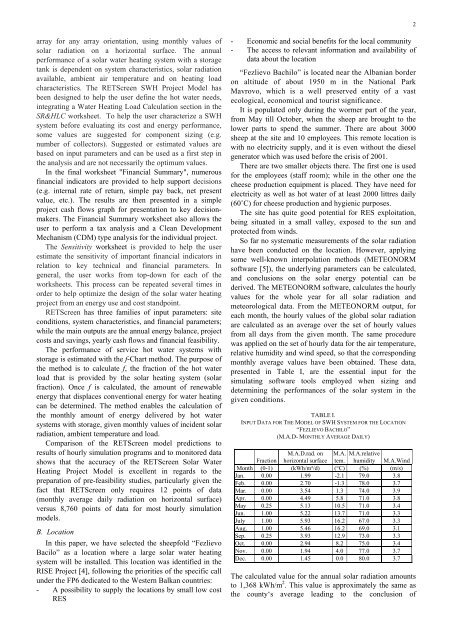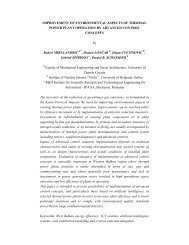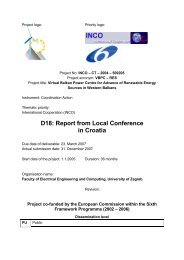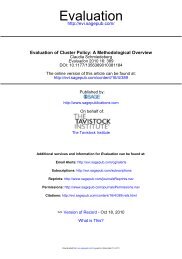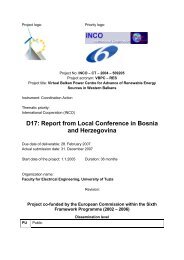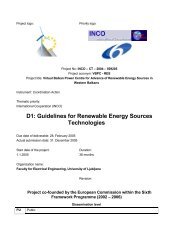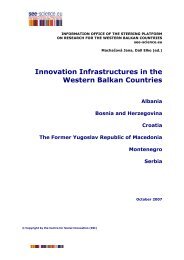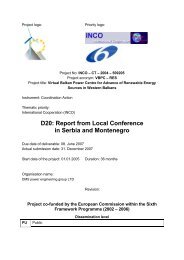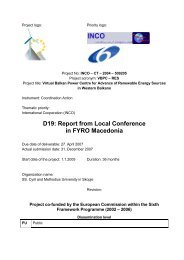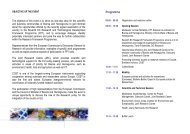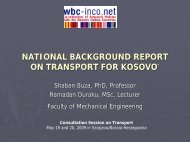Prva stran - WBC-INCO Net
Prva stran - WBC-INCO Net
Prva stran - WBC-INCO Net
Create successful ePaper yourself
Turn your PDF publications into a flip-book with our unique Google optimized e-Paper software.
array for any array orientation, using monthly values of<br />
solar radiation on a horizontal surface. The annual<br />
performance of a solar water heating system with a storage<br />
tank is dependent on system characteristics, solar radiation<br />
available, ambient air temperature and on heating load<br />
characteristics. The RETScreen SWH Project Model has<br />
been designed to help the user define the hot water needs,<br />
integrating a Water Heating Load Calculation section in the<br />
SR&HLC worksheet. To help the user characterize a SWH<br />
system before evaluating its cost and energy performance,<br />
some values are suggested for component sizing (e.g.<br />
number of collectors). Suggested or estimated values are<br />
based on input parameters and can be used as a first step in<br />
the analysis and are not necessarily the optimum values.<br />
In the final worksheet "Financial Summary", numerous<br />
financial indicators are provided to help support decisions<br />
(e.g. internal rate of return, simple pay back, net present<br />
value, etc.). The results are then presented in a simple<br />
project cash flows graph for presentation to key decisionmakers.<br />
The Financial Summary worksheet also allows the<br />
user to perform a tax analysis and a Clean Development<br />
Mechanism (CDM) type analysis for the individual project.<br />
The Sensitivity worksheet is provided to help the user<br />
estimate the sensitivity of important financial indicators in<br />
relation to key technical and financial parameters. In<br />
general, the user works from top-down for each of the<br />
worksheets. This process can be repeated several times in<br />
order to help optimize the design of the solar water heating<br />
project from an energy use and cost standpoint.<br />
RETScreen has three families of input parameters: site<br />
conditions, system characteristics, and financial parameters;<br />
while the main outputs are the annual energy balance, project<br />
costs and savings, yearly cash flows and financial feasibility.<br />
The performance of service hot water systems with<br />
storage is estimated with the f-Chart method. The purpose of<br />
the method is to calculate f, the fraction of the hot water<br />
load that is provided by the solar heating system (solar<br />
fraction). Once f is calculated, the amount of renewable<br />
energy that displaces conventional energy for water heating<br />
can be determined. The method enables the calculation of<br />
the monthly amount of energy delivered by hot water<br />
systems with storage, given monthly values of incident solar<br />
radiation, ambient temperature and load.<br />
Comparison of the RETScreen model predictions to<br />
results of hourly simulation programs and to monitored data<br />
shows that the accuracy of the RETScreen Solar Water<br />
Heating Project Model is excellent in regards to the<br />
preparation of pre-feasibility studies, particularly given the<br />
fact that RETScreen only requires 12 points of data<br />
(monthly average daily radiation on horizontal surface)<br />
versus 8,760 points of data for most hourly simulation<br />
models.<br />
B. Location<br />
In this paper, we have selected the sheepfold “Fezlievo<br />
Bacilo” as a location where a large solar water heating<br />
system will be installed. This location was identified in the<br />
RISE Project [4], following the priorities of the specific call<br />
under the FP6 dedicated to the Western Balkan countries:<br />
- A possibility to supply the locations by small low cost<br />
RES<br />
- Economic and social benefits for the local community<br />
- The access to relevant information and availability of<br />
data about the location<br />
“Fezlievo Bachilo” is located near the Albanian border<br />
on altitude of about 1950 m in the National Park<br />
Mavrovo, which is a well preserved entity of a vast<br />
ecological, economical and tourist significance.<br />
It is populated only during the wormer part of the year,<br />
from May till October, when the sheep are brought to the<br />
lower parts to spend the summer. There are about 3000<br />
sheep at the site and 10 employees. This remote location is<br />
with no electricity supply, and it is even without the diesel<br />
generator which was used before the crisis of 2001.<br />
There are two smaller objects there. The first one is used<br />
for the employees (staff room); while in the other one the<br />
cheese production equipment is placed. They have need for<br />
electricity as well as hot water of at least 2000 littres daily<br />
(60˚C) for cheese production and hygienic purposes.<br />
The site has quite good potential for RES exploitation,<br />
being situated in a small valley, exposed to the sun and<br />
protected from winds.<br />
So far no systematic measurements of the solar radiation<br />
have been conducted on the location. However, applying<br />
some well-known interpolation methods (METEONORM<br />
software [5]), the underlying parameters can be calculated,<br />
and conclusions on the solar energy potential can be<br />
derived. The METEONORM software, calculates the hourly<br />
values for the whole year for all solar radiation and<br />
meteorological data. From the METEONORM output, for<br />
each month, the hourly values of the global solar radiation<br />
are calculated as an average over the set of hourly values<br />
from all days from the given month. The same procedure<br />
was applied on the set of hourly data for the air temperature,<br />
relative humidity and wind speed, so that the corresponding<br />
monthly average values have been obtained. These data,<br />
presented in Table I, are the essential input for the<br />
simulating software tools employed when sizing and<br />
determining the performances of the solar system in the<br />
given conditions.<br />
TABLE I.<br />
INPUT DATA FOR THE MODEL OF SWH SYSTEM FOR THE LOCATION<br />
“FEZLIEVO BACHILO”<br />
(M.A.D- MONTHLY AVERAGE DAILY)<br />
M.A.D.rad. on M.A. M.A.relative<br />
Fraction horizontal surface tem. humidity M.A.Wind<br />
Month (0-1) (kWh/m²/d) (°C) (%) (m/s)<br />
Jan. 0.00 1.99 -2.1 79.0 3.8<br />
Feb. 0.00 2.70 -1.3 78.0 3.7<br />
Mar. 0.00 3.54 1.3 74.0 3.9<br />
Apr. 0.00 4.49 5.8 71.0 3.8<br />
May 0.25 5.13 10.5 71.0 3.4<br />
Jun. 1.00 5.22 13.7 71.0 3.3<br />
July 1.00 5.93 16.2 67.0 3.3<br />
Aug. 1.00 5.46 16.2 69.0 3.1<br />
Sep. 0.25 3.93 12.9 73.0 3.3<br />
Oct. 0.00 2.94 8.2 75.0 3.4<br />
Nov. 0.00 1.94 4.0 77.0 3.7<br />
Dec. 0.00 1.45 0.0 80.0 3.7<br />
The calculated value for the annual solar radiation amounts<br />
to 1,368 kWh/m 2 . This value is approximately the same as<br />
the county‘s average leading to the conclusion of<br />
2


